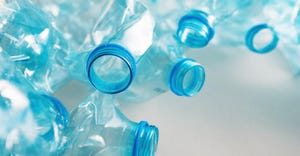The Recycling Partnership Doubles Down to Boost PET Recovery
The Pico Rivera facility in Los Angeles County, which processes input from multiple MRFs, is homing in on polyethylene terephthalate (PET), especially a few less-captured materials: pigmented and opaque PET and non-bottle PET (aka thermoforms) such as containers and cups. The California operation is getting help from The Recycling Partnership.

As extended producer responsibility laws (EPR) take shape, materials recovery facilities (MRFs) and packaging materials reclaimers are anticipating huge spikes in plastics flowing into the recycling stream. Pico Rivera, a secondary sort business in Los Angeles County, is among them. The large facility, which processes input from multiple MRFs, is homing in on polyethylene terephthalate (PET), especially a few less-captured materials: pigmented and opaque PET and non-bottle PET (aka thermoforms) such as containers and cups.
The California operation is getting help from The Recycling Partnership—grant monies to put toward an optical sorter and related equipment that the facility’s operator Valemi says will bump its sorting capacity by 3.73 million pounds a year—representing a 70 percent increase.
Pico Rivera is one of many players in the PET market tapping into support from The Partnership. Since June 2022, the nonprofit’s PET Coalition has deployed over $5 million to 23 MRFs, secondary sorters, and reclaimers to capture and process more of this plastic type, expanding collections to 1.5 million U.S. households and aiding in recovering another 29 million pounds each year. The Partnership and Coalition are shooting to see that another 250 million pounds are captured yearly by the end of 2027 and are especially targeting the thermoforms and pigmented and opaque PET that Pico Rivera is after.
The focus on this particular polymer is driven by dismal realities: only 28 percent of residential PET bottles are recycled; 18 percent of PET packaging is thermoform, yet less than 60 percent of U.S. households have a recycling program that accepts this PET. Packaging like egg cartons, trays, and tubs are only recycled at a 9 percent rate.
Part of the problem is that about a quarter of PET bottles and half of non-bottle PET coming into MRFs can be lost to other streams. Many operators say they are overburdened with material, lacking a system to catch much more.
And marketing both thermoforms and opaque and pigmented PET is tough, largely because reclaimers lack technical abilities to work with them.
Yet research demonstrates it’s technically straightforward to make recycled products from all these materials with existing sorting technology. And brands are clamoring for more recycled content, says Brittany LaValley, vice president of Material Advancement, The Recycling Partnership.
The PET Coalition, launched in June 2022 with like-minded partners, makes grants available to replace old and insufficient sorting technology; to upgrade equipment with more sophisticated means of distinguishing between PET bottles, thermoforms, and pigmented/opaque PET; and for additional sorting equipment. Monies can also be used for community outreach to boost recycling rates.
The initiative follows the collaborative model of The Partnership’s Polypropylene Recycling Coalition.
Recycling challenges are only intensifying amid ambitious new EPR targets and recycled content mandates, which some industry stakeholders believe will bring a watershed of opportunity to beef up their business.
Ontario is in the midst of transitioning to full EPR for multiple materials, including plastics. Ice River Sustainable Solutions (IRSS), recycled bottle suppliers in that province, are getting ready with help from a PET Coalition grant.
The company receives PET bales from MRFs across North America and is looking to create new end products with more forms of this material.
Its facility, Blue Mountain Plastics, already recycles 55 million pounds of PET per year but will soon be able to process 30 million more pounds, including commingled loads of bottles and thermoforms, pigmented and opaque materials.
Justin Gott, the company’s vice president of Engineering, sees a strong business case for the investment.
"The demand for finished recycled plastics continues to outpace the available supply," Gott says. "We continue to see our recycling operations as a significant growth engine for our company."
“It helps to understand where losses are happening and identify MRFs with high success in capturing bottles and thermoforms so we can identify best practices,” LaValley says.
Upgrading opticals for PET bottle sortation can meaningfully increase overall capture rate. Quality control on both the fiber and last chance lines has proven successful in increasing capture of thermoforms and bottles as well, she says.
The recycling landscape continues to shift, especially on the policy front. The Partnership, along with states, is keeping its eye on EPR, with plans to capitalize on anticipated opportunity while aligning its national goals with the goals of EPR systems.
A few states are leading the way. By 2032, all packaging considered recyclable in California needs to meet a 65 percent recycling rate. And states like Oregon and Colorado have EPR framework, but it won’t unlock the full opportunity for non-bottle PET circularity unless sufficient end markets exist, cautions LaValley.
“Our Coalition granting has helped develop those end markets, but more work is needed.
“The task at hand may be daunting but building a better recycling system is within reach. The right people, ideas, funding, and solutions must be connected, and The Recycling Partnership through the work of the Coalition looks to continue doing this work,” she says.
The job goes beyond funding infrastructure because being able to capture and process materials hinges on community engagement. With that understanding The Partnership has helped fund community education programs. And it’s developed a tool called Recycle Check, an interactive platform providing consumers with localized package-specific recycling information.
“We knew that companies wanted more recycled PET for packaging; MRFs wanted to increase the amount and types of PET collected; and reclaimers needed more supply, as well as the capacity to process it.
“Improving each of these functions, in addition to community outreach and education, is paramount to building a better recycling system for PET and all materials,” LaValley says.
To date, The Partnership has deployed over $69 million in grants to try and increase local recycling access and education, and to support over 100 recycling facilities working to capture and process multiple materials.
About the Author
You May Also Like




.png?width=300&auto=webp&quality=80&disable=upscale)